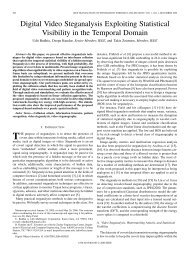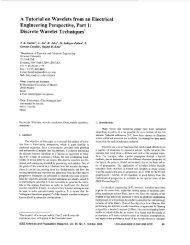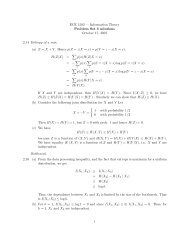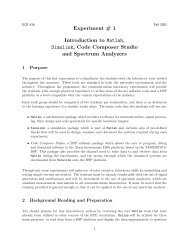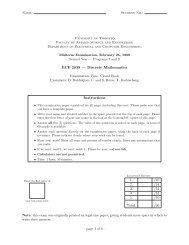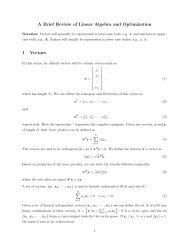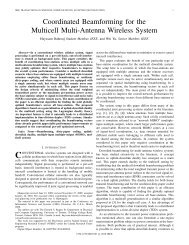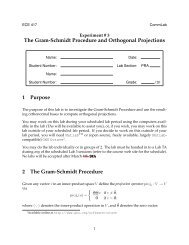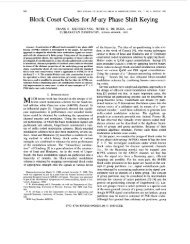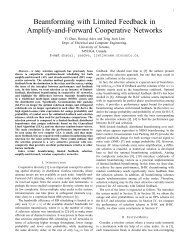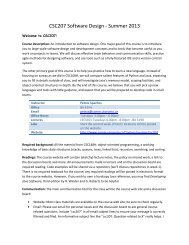IEEE TRANSACTIONS ON VERY LARGE SCALE INTEGRATION SYSTEMS 6Average ratio of active iterations, α10.90.80.70.60.50.40.30.20.1I M= 4I M= 8I M= 12I M= 16Average ratio of active iterations, α10.90.80.70.60.50.40.30.20.1I M= 4I M= 8I M= 12I M= 16FromchannelIntrinsicmemoryOutputbufferDecodedbitsVNUsCNUsENENENVNU 1VNU 2InterconnectionsControlCNU 1CNU 2ENCNU CVNU VENENCheck_enableVariable_enableXOR_outOR treeEnablelogicClkNew_frameReset04 4.5 5 5.5Eb/N0 (dB)(a)04 4.5 5Eb/N0 (dB)(b)Fig. 11. The fully-parallel iterative <strong>LDPC</strong> decoder with early terminationfunctionality.Fig. 10. Ratio of active iterations (a) Reed-Solomon based (6, 32)-regular2048-bit code and (b) PEG (4, 15)-regular 660-bit code.Evenframes# n-2I Miterations# n# n+2nodes in every iteration where syndrome checking can beper<strong>for</strong>med. This distribution can be done either by dedicatingextra hard wires from VNUs to the neighboring CNUs, orby sharing the same wires used <strong>for</strong> transferring extrinsicmessages in a bit-serial time multiplexed fashion. But neitherof these approaches are efficient because they either increasethe routing complexity by adding global wires or decreasedecoding throughput by increasing the number of clock cyclesper iteration.Alternatively, in this work we check the parity of the normalvariable-to-check messages that are already required by thedecoding iterations. If the parity of all these messages are satisfied,we stop decoding <strong>for</strong> that frame and compute the finalhard decision at the beginning of next iteration. Although notmathematically equivalent to the standard syndrome checking,we have simulated the two <strong>LDPC</strong> codes of Fig. 8 with the sameset of 10 6 frames both without and with early termination atEb/No ranging from 4 dB to 5.1 dB. The simulations showidentical per<strong>for</strong>mance between the two approaches <strong>for</strong> thesecodes.For the two codes discussed in this paper, our method onaverage needs one extra iteration to terminate compared withthe conventional syndrome checking method. This differencereduces the amount of power savings achieved compared tothe conventional syndrome checking. For example, in the 660-bit decoder presented in Section II.C, conventional syndromechecking could have improved the percentage of power savingsfrom 49% to 51% <strong>for</strong> low-SNR inputs (Eb/No ≈ 3 dB) andfrom 66% to 72% <strong>for</strong> high-SNR inputs (Eb/No ≈ 6 dB).In spite of the reduced power savings, we have adopted thisnew termination method <strong>for</strong> two reasons. First, in contrast toconventional early termination our termination method doesnot increase the number of VNU-to-CNU wires, nor does itrequire extra clock cycles per iteration to distribute the harddecision results to the CNUs. Second, this approach requiresminimal hardware overhead since most of the calculations arealready part of the normal VNU and CNU operations.OddframesEvenframesOddframesOR-treeoutput# n-2# n-1# n-1# n(a)I Miterations(b)# n+1# n+1# n+2Fig. 12. Block-interlaced decoding timing diagram (a) without earlytermination, (b) with early termination.Fig. 11 shows the block diagram of a decoder with earlytermination logic. It is similar to the one in Fig. 5 with afew added blocks: First, all the parity results are ORed. Theoutput of the OR tree is zero only when all the paritiesare satisfied. Second, a termination logic block generatesthe proper disable/enable signals <strong>for</strong> the VNUs and CNUsdepending on the value of the OR tree output. If the output ofthe OR tree is zero, it keeps the VNUs and CNUs disabled <strong>for</strong>the remaining iterations. Fig. 12 shows the timing diagrams ofthe decoder, with and without early termination. It shows thatthe decoding throughput is the same in both cases since thestart time <strong>for</strong> decoding the frames is identical. However thepower consumption is reduced in Fig. 12 because the decoderis turned off as soon as a correct codeword is detected.The synthesis results show that the added OR tree and theenable/disable functionality required in CNUs and VNUs addsonly less than 0.1% and 0.5% to the total decoder gate count,respectively. It should also be noted that no additional logic isrequired inside the CNUs to generate the XOR-out signals as
IEEE TRANSACTIONS ON VERY LARGE SCALE INTEGRATION SYSTEMS 7Control pins300ExtrapolatedMeasured1500ExtrapolatedMeasured3 mm44inputpins660VNUs&176CNUs44outputpinsMax. Frequency (MHz)250200150100<strong>Power</strong> (mW) (@ max. frequency)10005003 mm500.6 0.8 1 1.2V dd(V)00.6 0.8 1 1.2V dd(V)Fig. 13.Decoder die photo.<strong>Power</strong> (mW) (300 MHz, 1.2V)Fig. 14.16001200800400No early terminationWith early termination02 3 4 5 6 7 8Eb/No (dB)Decoder power consumption vs. input SNR.this value is already available from the sign-calculation blockinside the CNUs (Fig. 6).IV. RESULTSFig. 13 shows the die photo of the implemented decoder.The decoder per<strong>for</strong>ms 15 decoding iterations per frame as itwas shown in Fig. 8(b) that per<strong>for</strong>ming more than 12 iterationsresults in a negligible BER enhancement. It occupies 7.3 mm 2core area and operates at maximum frequency of 300 MHzwith a 1.2-V core supply voltage which results in a 3.3 Gbpstotal throughput. Since the code rate is 0.74, this correspondsto an in<strong>for</strong>mation throughput of 2.44 Gbps. The measuredBER per<strong>for</strong>mance of the decoder matches bit-true simulations.The BER curve is practically identical to the BER graph inFig. 8(b) <strong>for</strong> I M = 16.The total decoder power consumption is shown in Fig. 14as a function of input SNR at 300 MHz with 1.2-V supplyvoltage. The solid line in this graph is directly obtained frommeasurements. It was observed that approximately 20% of thetotal power dissipation is due to the clock tree. It was alsoFig. 15. Effect of supply voltage scaling on maximum frequency and powerconsumption.observed that only less than 1.4 mW (i.e., 0.1% of the totalpower consumption) is due to leakage current. The graph inFig. 14 also shows that in contrast to the fully-parallel <strong>LDPC</strong>decoder in [11], the power consumption is relatively flat <strong>for</strong> theSNR values of interest in this work. This is mostly becauseof the bit-serial message-passing and the block interleavingarchitecture which tend to maintain high switching activityindependent of the input SNR.The power consumption resulting from early termination asproposed in this work is shown by the dotted line in Fig. 14.Since early termination logic was not included in the fabricatedprototype, we have calculated the P D ′ data points on the dottedline from the P D data points on the solid line usingP ′ D = (1 + γ)(p c + α(1 − p c ))P D ,where γ accounts <strong>for</strong> the overhead of the early terminationlogic, p c is the fraction of dynamic power attributable to theclock tree, and α is the ratio of active iterations similar tothe values plotted in Fig. 10(b). This expression accounts <strong>for</strong>the fact that early termination does not decrease the dynamicpower in the clock tree. As explained in Section III, γ <strong>for</strong> thereported decoder is estimated to be less than 0.006. As alsomentioned, our measurements show that p c is approximately0.2. The figure shows that early termination reduces the powerconsumption by between 58% and 66% in the practical SNRrange of interest between Eb/No=4 dB and Eb/No=5.5 dB.Fig. 15 shows the effect of supply-voltage scaling on themeasured maximum frequency and the total power dissipationat that frequency. The dotted lines are the predicted valuesbased on the MOS square-law equation with V t = 0.3V .It can be seen that the measured results closely follow thepredicted results both <strong>for</strong> maximum frequency and <strong>for</strong> thepower consumption.Table I summarizes the characteristics of the fabricateddecoder. In Table II the results from other <strong>LDPC</strong> decodersreported in literature are listed. The decoder architecture in



